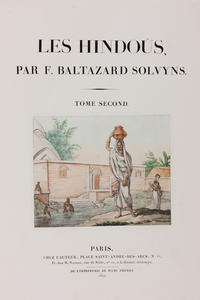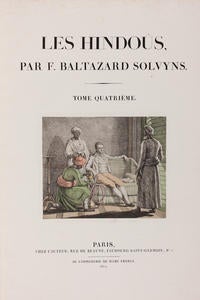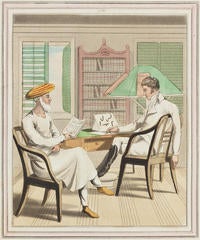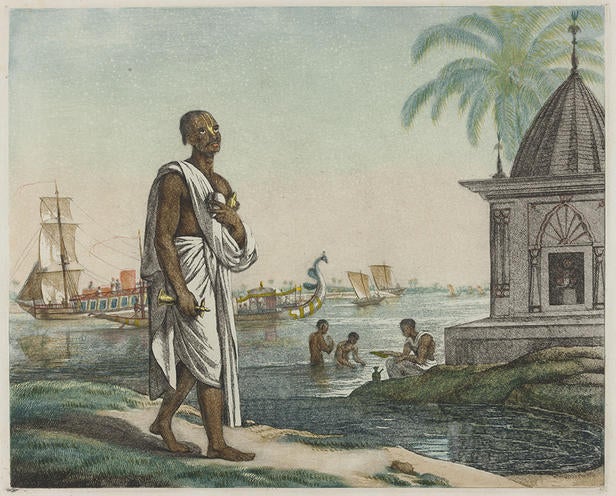 François Balthazar Solvyns, Les Hindoûs. Paris, L'auteur, 1808-1812.
François Balthazar Solvyns, Les Hindoûs. Paris, L'auteur, 1808-1812.
François Balthazar Solvyns (1760-1824) was a Flemish artist who lived in Calcutta from 1791 to 1803. While in India, Solvyns initiated an extensive ethnographic survey of the people of Bengal. Titled A Collection of Two Hundred and Fifty Coloured Etchings: Descriptive of the Manners, Customs, and Dresses of the Hindoos, the 1799 work was ultimately a financial and aesthetic failure. However, it became a preliminary draft of Les Hindoûs. After returning to Europe, Solvyns reconfigured his earlier work by improving and increasing the number of plates to 288 and enlarging the accompanying text in both French and English. The complete  work was published in Paris between 1808-1812 and consisted of four volumes that had different areas of focus. The first volume provided descriptions of castes and classes among the Hindus, the second highlighted the costumes, ways of life, and amusements of the Hindus, the third detailed other subjects pertinent to the costumes of the Hindus, and the final volume focused on the classes of domestics serving wealthy Indians and Europeans. Solvyns expressed an Orientalist-inspired admiration for Hindu culture, depicting the characters as individuals as opposed to generic types. His work is a sumptuous early example of ethnography, establishing a visual precedent for later artists who engaged with India’s diverse population.
work was published in Paris between 1808-1812 and consisted of four volumes that had different areas of focus. The first volume provided descriptions of castes and classes among the Hindus, the second highlighted the costumes, ways of life, and amusements of the Hindus, the third detailed other subjects pertinent to the costumes of the Hindus, and the final volume focused on the classes of domestics serving wealthy Indians and Europeans. Solvyns expressed an Orientalist-inspired admiration for Hindu culture, depicting the characters as individuals as opposed to generic types. His work is a sumptuous early example of ethnography, establishing a visual precedent for later artists who engaged with India’s diverse population.
Sara Miller McCune Collection
 Sir Charles Doyley, The Costume and Customs of Modern India, London: Printed and sold by Edward Orme, 1825.
Sir Charles Doyley, The Costume and Customs of Modern India, London: Printed and sold by Edward Orme, 1825.
Sir Charles Doyley (1781-1845) was a British amateur artist who was born in Calcutta to a nabob (wealthy East India Company officer). Doyley was educated in England, but joined the East India Company and returned to India in 1789. While working as a collector in Dhaka from 1808-1818, Doyley and his wife began taking drawing lessons from well-known artist George Chinnery. In his lifetime Doyley produced numerous picturesque landscapes of India and went on to found an art society in Patna. Doyley left India in 1838.
His 1825 work The Costume and Customs of Modern India focused on Anglo-Indian life. Doyley includes scenes of Europeans juxtaposed with their servants and entertainers, along with textual information describing the activity and the type of native servant. The work functioned as a kind of guide for Britishers traveling to India because it provided them with useful hints about life in India. Doyley’s representations are mildly satirical, but ultimately provide an important window into Anglo-Indian social relations of the time.
Sara Miller McCune Collection
John Malcolm, Sketch of the Sikhs, a Singular Nation, Who Inhabit the Provinces of the Penjab, Situated Between the Rivers Jumna and Indus. London: J. Murray. 1812.
John Malcolm (1769-1833) was an East India Company army officer and diplomat. In 1805 Malcolm went on an expedition to the Punjab with Lord Lake and came in contact with the Sikhs. On this trip he observed the rituals and culture of Sikhism and committed himself to learning the fundamentals of their religion and reading primary sources. Sketch of the Sikhs presents his observations for a British audience. It is one of the first works written by a European that engages with Sikhism. Malcolm’s book is finely detailed and expresses admiration for the Sikhs. His admiration was in part inspired by the military history of the Sikhs, which was appealing to him because of his own army training. Ultimately, this account of Sikhism proved to be superior to any written by his predecessors. It is an early work of ethnography that was highly esteemed and remains an influential work for scholars of Sikhism even today.
UCSB Library Collection (DS485.P3 M35 1812), Gift of Sara Miller McCune
< Previous | Online Exhibition Home | Next >



